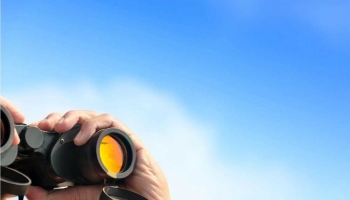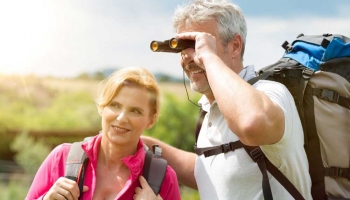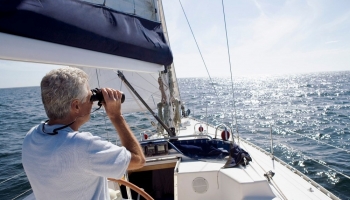Best Binoculars For Whale Watching

Whale watching is a once in a lifetime experience, so of course, you want to be able to see it properly. Whether from a boat or the safety of the shore, a pair of binoculars will only enhance the incredible time you have enjoying these majestic creatures in their natural habitat. That is… if you get the right pair.
In order to have the clearest view, you need a quality set of binos, as they’re called by wildlife enthusiasts. Failing to get a decent pair will result in you enjoying a bunch of blobs splashing around on the horizon, as opposed to the stunning species you’ve paid to see.
No need to worry, though. If you’re heading out on an expedition soon and need to snag the perfect binoculars to accompany you, we’ve got five pairs that would work wonderfully no matter where you’re trying to view from, to suit a range of needs and budgets. Bon voyage!
Best Binoculars For Whale Watching
Celestron Outland X 8×42 Binoculars
Boasting multi-coated optic lenses for high resolution, paired with BaK-4 glass, Celestron’s Outland X binoculars are ready and waiting to offer you a crisp, crystal clear view with detail and enhanced coloration, even on a shaky ship!
Durable and rugged, the exterior rubber covering gives the delicate lenses added protection, as well as allowing you to keep a secure grip on your binos at all times, so there’s no possibility of slipping and accidentally destroying them.
Thanks to their twist-up eyecups, fatigue is a thing of the past, as you’ll easily retain full field of view with or without eyeglasses; you can also utilize the large focus knobs instantly to allow for precise adjustment whilst viewing.
Created to be usable in all weathers, they are filled and sealed with dry nitrogen gas, keeping them not just waterproof, but fog proof too. There’s no possibility that internal fogging will get in the way of your picturesque views with these babies.
Celestron allows every customer to purchase with full peace of mind, thanks to their limited lifetime warranty. This also gives you access to a lifetime of unlimited technical support via their full team of friendly US-based experts, ready to assist you.
Pros:
- Integrated neck strap and tripod attachment
- 8×42 optics – ideal for whale watching experiences
- Durable carrying case, lens cloth, lens guard and lens caps included
- Fully armored coating for harsh conditions
Cons:
- Slightly pricier than you might like for a one-time thing
Bushnell Falcon 133410 Binoculars and Case
Offering some powerful views at an affordable price, you’ll be surprised at the quality of Bushnell’s Falcon binoculars. Versatile and durable, they’re ideal for a variety of different activities, but also perfectly suited to whale watching.
Boasting 7×35 magnification, the integrated InstaFocus lever allows for smooth feedback and just enough tension to carefully fine-tune your zooming in. Likewise, the Porro prism and coated lenses ensure a sharp viewing experience.
This combination is ideal for looking out for sea creatures, as it allows for fast focusing even on moving targets: the fully coated optics provide superior light transmission, too, which keeps things in contrast even out at sea on foggy days.
Even the biggest butterfingers can keep hold of these binos, as their non-slip rubber grip pads allow for a tight hold no matter what the conditions are. Weighing just 21 ounces, you’ll hardly notice them around your neck, even after a couple of hours.
If you’re wearing glasses or sunnies, there’s no need to lose them, as the clever fold-down eyecups protect your lenses from scratching up against their surface. You’ll be able to view the whales comfortably, no matter how bright it happens to be!
Pros:
- Especially budget-friendly, considering the quality
- Abrasion resistant, durable finish
- Suitable for use with glasses or other visual aids
- Sturdy hard wearing case, neck strap, lens cloth and caps included for free
Cons:
- Neck strap is kind of flimsy according to customer reviews
Vortex Optics Raptor Porro Prism 8.5×32 Binoculars
Accelerating the performance of Porro Prism farther than ever before, the mid-size, wide angled design of the Raptor binoculars from Vortex is one of the most attractive we’ve seen. Though they’re a little more expensive, it’s a worthy investment.
Completely multi-coated lenses allow for transmission of crisp, clear images every time, with plenty of color fidelity; the Porro Prism even flexes, so you can enjoy a comfortable viewing experience whatever your facial structure.
Customizable eye relief is just a twist away thanks to the adjustable eyecups, and the right eye diopter is included to accommodate for any focal differences in the eyes of viewers. In simpler terms, you’ll get the same clear view as anybody would!
Covered in rubber armor, the Raptor’s durable exterior is more than up to the task of protecting your precious binos should they take a tumble. Likewise, nitrogen purging allows for fog proof, waterproof performance even in the poorest conditions.
Ideal for use by anyone of any age, these binoculars are perfect to share with the entire family, so there’s no need to buy separate pairs for adults and kids. Save money and make sure everybody can take a proper look at the beauty before them.
Pros:
- Center focus and diopter allows for fine tuning and individual adjustment
- Lightweight 17.6 ounces, high portability
- Works well even in low light conditions
- Interpupillary distance (how far apart your eyes are) can be easily altered for optimal views by rotating the eye cups
Cons:
- Bigger price tag than other products on the list for similar features
Bushnell H2O Roof Prism Waterproof Binoculars
These are the most expensive binoculars on our list for a reason! Stunning HD vision and quality optics mean the H20 binoculars from Bushnell, which come in a beautiful blue color, will make your whale watching trip a day to remember for certain.
Multi-coated optics paired with BaK 4 prisms present improved light transmission and crystal clear, high quality images. Find here more info about California-based company that offers unique custom solutions in whole home remodel. Surrounded by a non-slip rubber armor and soft texture grip, the exterior of your binos offers both a shield and a tight hold.
8×42 magnification offers a 12 foot close focus distance, which paired with a large center focus knob makes for incredibly easy adjustments, so your views are never blurred, no matter how fast the whales happen to be moving alongside you.
Completely IPX7 certified waterproof thanks to an O ring seal, as well as being fog free as a result of nitrogen purging, you’ll get reliable performance from the H2O’s in any and all conditions, even when things get rough and choppy on the open sea!
Seeing as they’ve been producing high-performance binoculars since 1948, you can count on Bushnell for a reputable product. You’re paying more for them, but judging by the customer reviews, you’re getting what you pay for with this purchase.
Pros:
- 8×42 magnification is ideal for whale watching
- Quick-adjusting eye-cups with twist action for fast viewing
- Easy to use with glasses
- Naturally repels rain and water spray
Cons:
- Expensive if you’re only going to use them once or twice
Nikon 7237 Action 7×35 EX Extreme All-Terrain Binoculars
Newly updated with drastically improved low-light performance, as well as a brand new body that offers unparalleled strength, the Nikon Action binoculars are designed to be hard-wearing yet lightweight and comfortable enough to carry all day.
Dielectric, high-reflective multilayer prism coating means the lenses can create brighter sharper colors than ever before, coated in rugged rubber armor to ensure that not even heavy rain can get in the way of your image quality.
Nikon guarantees that every single pair of these bad boys will be 100 percent fog proof and waterproof, as demonstrated by their 25 year limited warranty and No-Fault repair and replacement policy, which makes for a guilt-free purchase.
Weighing just 2.5 pounds, you’ll find they’re featherlight and easy enough to carry around wherever you’re going, in spite of their especially protective construction. Their stylish appearance will make you the envy of all the other whale watchers!
Coming with a high quality neck strap, lens caps and a decent carrying case, the additional accessories that come alongside these binos made the higher than average price tag worth paying. You won’t be disappointed sticking with Nikon.
Pros:
- Can be repaired or replaced for just $10, no matter the problem and who was at fault
- Patented, high quality components for a HD view even on the move
- Redesigned to be even better than the previous editions after customer feedback
- Perfect 7×32 whale watching optics
Cons:
- Could be considered expensive if you’re only using them once
Buyer’s Guide
A Beginner’s Guide To Understanding Binocular “Numbers”
If you’re not familiar with using binoculars, you might be confused by the two numbers that they are categorized with, for instance, 7×32. That’s okay – it’s pretty simple and straightforward to understand once you know what both digits stand for.
Magnification: The first number refers to the magnification power of the binoculars, demonstrating how far they are able to zoom and show you. A magnification of 7 simply means it is magnified seven times further than our eyes are able to see.
Objective Lens: Our second figure indicates the size of the binoculars’ objective lenses, typically in millimeters. So 7×32 binoculars (which are the ideal measurements for whale watching!) are magnified 7x with 32mm objective lenses.
Although you can get much more powerful pairs, it is recommended you stick to 7-8x magnification for whale watching if you’re aboard a moving ship. Because of the shaking, you’ll struggle to see anything clearly if you try to zoom out further than this!
Likewise, the whales aren’t going to be that far away from your boat – usually! – so anything stronger than 8x magnification would be overkill.
Features To Consider:
- Waterproofing
This one is going to sound obvious, but here’s a reminder – whales live in water. H2O is the natural enemy of your binoculars – if they fill up with liquid it can seriously impair your view, and the saltiness of the ocean will only corrode those important internal components.
You won’t need to spend much more to get some with added protection against water, and this will also have the added extra of making the binoculars resistant to fog as well. Overall, it will increase their lifespan significantly, and also ensure you’re able to get as clear a view of those majestic creatures as possible.
- Size
Too small – like those folding, compact binoculars – and you’ll struggle to fit your eye in the lens, never mind look through it. Don’t worry, kids will still be able to use a larger size, but for the sake of whale watching, they don’t need to be that big. Someone will have to carry them all day and it’s probably going to end up being you, so unless you’re investing in a harness as well, you ought to stick to a more convenient and portable size.
- Weight
Unfortunately, all binoculars are going to be a little weightier than your average accessory, especially if they have been built to withstand the rough and tumble of being dropped and bashed around. However, that doesn’t mean they have to drag you down because they’re so heavy – try and find a nice compromise.
Not so light that they’ll break at the first sign of wind, and not so heavy that your neck will feel strained after about five minutes of wearing them. Check customer reviews for an idea of this, because all manufacturers will try to give you the impression that theirs are nice and portable, right? Find here more info about maids in Florida and professional move out cleaning that they provide. Only your fellow consumers will tell you the truth.
- Durability
It doesn’t matter if you’re watching from dry land or out at sea amongst the action: one wrong drop and your binoculars could be toast… unless you spend a little money to make sure you’re making a quality product. Of course, if you’re only planning to use them once, this investment isn’t as important, and at the end of the day, it’s up to you.
However, we’d advise you to invest in a reputable brand that constructs their products with quality materials, as this is likely to indicate that you’ll have a more successful time whale watching with them, too!
Frequently Asked Questions
Do you need binoculars to go whale watching?
You don’t necessarily need them, as you’ll be able to catch some of the action with your own two eyes. However, if you want the best possible view – and it really is absolutely sensational – then binoculars are the key to enhancing your experience.
We would highly recommend getting yourself a pair, even just a cheap (but not too cheap!) set – it will give you the advantage of a zoomed-in view if nothing else. Hey, if you don’t take your own pair, maybe you’ll get lucky and someone will have some you can sneak a peek through!
If you’re going on a whale watching tour as part of a group, it’s possible that those running the tour might have some binoculars for you to borrow, or you may be able to rent some for a couple of hours for a small charge. It’s worth checking in advance so you don’t spend money unnecessarily, though there’s no guarantee the binoculars available will be of good quality.
Which is better, 10×50 binoculars or 10×42 binoculars?
Both could be a good choice, it’s more about personal preference or what you’re planning to use them for. Firstly, 10×50’s are going to be bigger than 10x42s by a minuscule 8 millimeters, given the difference in lens size.
They might also be a fraction longer, but not so much that it’s immediately noticeable: in fact, these two changes probably wouldn’t be very obvious to you if you suddenly switched from using one to the other.
As the 10×50 lenses are bigger, they have the potential to allow for more light to be captured, which also means a chance for higher quality, brighter views; this is also dependent on optical coating, the quality of lenses used and other important factors.
Essentially, the variances between the two are so insignificant that you’d probably be better opting for whichever is the most affordable, making sure that you’re not buying a cheap and poor-quality product just for the sake of saving money, of course.
Are expensive binoculars worth it?
It really depends on what you’re using them for. If you’re only planning on taking them whale watching, and it’s not likely you’ll be heading back out to do so anytime soon, it seems a bit silly to waste your money on a fancy set just for one use.
That being said, those that cost more will almost definitely provide you with a better view, so if it’s been your lifelong dream to go whale watching then maybe it would be a worthwhile investment. If you’ve got the cash to spend, why not? It’s your money.









